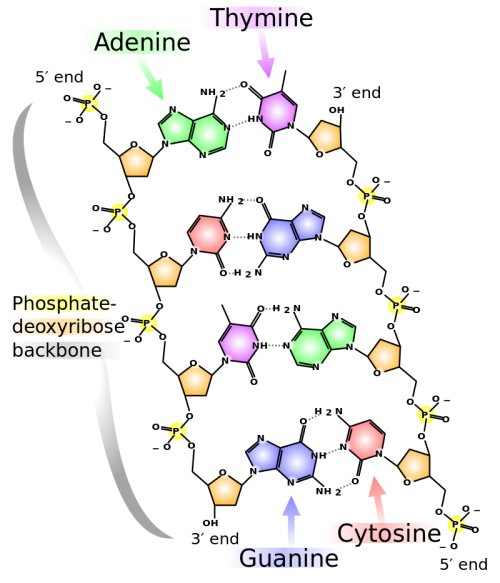3.5 Nucleic Acids
Nucleic acids are key macromolecules in the continuity of life. They carry the genetic blueprint of a cell and have instructions for the functioning of the cell.
Nucleic acids are made up of monomers known as nucleotides. The nucleotides combine with each other to form a polynucleotide, DNA, or RNA. Each nucleotide comprises a nitrogenous base, a pentose (five-carbon) sugar, and a phosphate group.

Types of Nucleic Acids
The two main types of nucleic acids are deoxyribonucleic acid (DNA) and ribonucleic acid (RNA). The specific sugars are slightly different for the DNA and RNA molecules, and the names of these molecules come from the sugars in their nucleotides; DNA contains the sugar deoxyribose, while RNA contains the sugar ribose.
DNA
DNA is the genetic material found in all living organisms, ranging from single-celled bacteria to multicellular mammals.
Each nucleotide in DNA contains one of four possible nitrogenous bases: adenine (A), guanine (G), cytosine (C), and thymine (T). The order of the bases determines the information that the DNA carries. This is because the order of the bases in a DNA gene determines how amino acids will be assembled to form a protein.
DNA has a double-helical structure. It is composed of two strands, or polymers, of nucleotides. The strands are formed with covalent bonds between phosphate and sugar groups of adjacent nucleotides, and the nucleotides are bonded together using dehydration synthesis. The strands are bonded to each other at their bases with hydrogen bonds, and the strands coil about each other along their length, hence “double helix”, which means a double spiral.
The alternating sugar and phosphate groups lie on the outside of each strand, forming the backbone of the DNA. The nitrogenous bases are stacked in the interior, like the steps of a staircase, and these bases pair; the pairs are bound to each other by hydrogen bonds. The bases pair so that the distance between the backbones of the two strands is the same all along the molecule. The rule is that nucleotide A pairs with nucleotide T and G with C; see section 9.1 for more details.

RNA
The other type of nucleic acid, RNA, is mostly involved in protein synthesis. The DNA molecules never leave the nucleus; instead, they use an RNA intermediary to communicate with the rest of the cell. This intermediary is the messenger RNA (mRNA). Other types of RNA—like rRNA, tRNA, and microRNA—are involved in protein synthesis and its regulation. RNA nucleotides also contain one of four possible bases: adenine, guanine, cytosine, and uracil (U) rather than thymine.
| Feature | DNA | RNA |
|---|---|---|
| Function | Carries genetic information | Involved in protein synthesis |
| Location | Remains in the nucleus | Leaves the nucleus |
| Structure | DNA is a double-stranded “ladder”: sugar-phosphate backbone with base rungs. |
Usually single-stranded |
| Sugar | Deoxyribose | Ribose |
| Nitrogenous Bases | Adenine, Guanine, Cytosine, Thymine | Adenine, Guanine, Cytosine, Uracil |
“2.3 Biological Molecules” from Biology and the Citizen by Colleen Jones is licensed under a Creative Commons Attribution 4.0 International License, except where otherwise noted.

